The last few years have been marked by uncertainty.
After the boom and subsequent pandemic contraction, ecommerce merchants have been left reeling.
Right now, we’re looking for any possible way to stretch our dollars just a little further.
For ecommerce sellers, that solution might be marketing and email automation software.
We analyzed over a million emails sent over the last year to see how merchants were using automation, and which automated workflows made the biggest impact for them.
And the results are in.

Segmentation May Just Be the Key to 5x More Revenue
Segmentation is the one thing that ecommerce marketers slack on the most. Whether you don’t have any good segmentation ideas, or it feels too complicated, or you just don’t know what segments you should have, it’s a lost opportunity for many.
When we looked into the data from last year, the findings shocked us: only 1 in 5 ecommerce merchants were actually using segments.
This means that ecommerce merchants were sending the same emails to their entire list without any kind of targeting in place.
While for some industries and smaller email lists, segmentation might not be a top priority, it’s one of the easiest ways to generate more revenue in ecommerce.
How do we know for sure? We found that merchants using segments were earning five times more revenue than merchants who weren’t.
This means that only 20% of ecommerce merchants were scooping up 80% of all revenue generated.
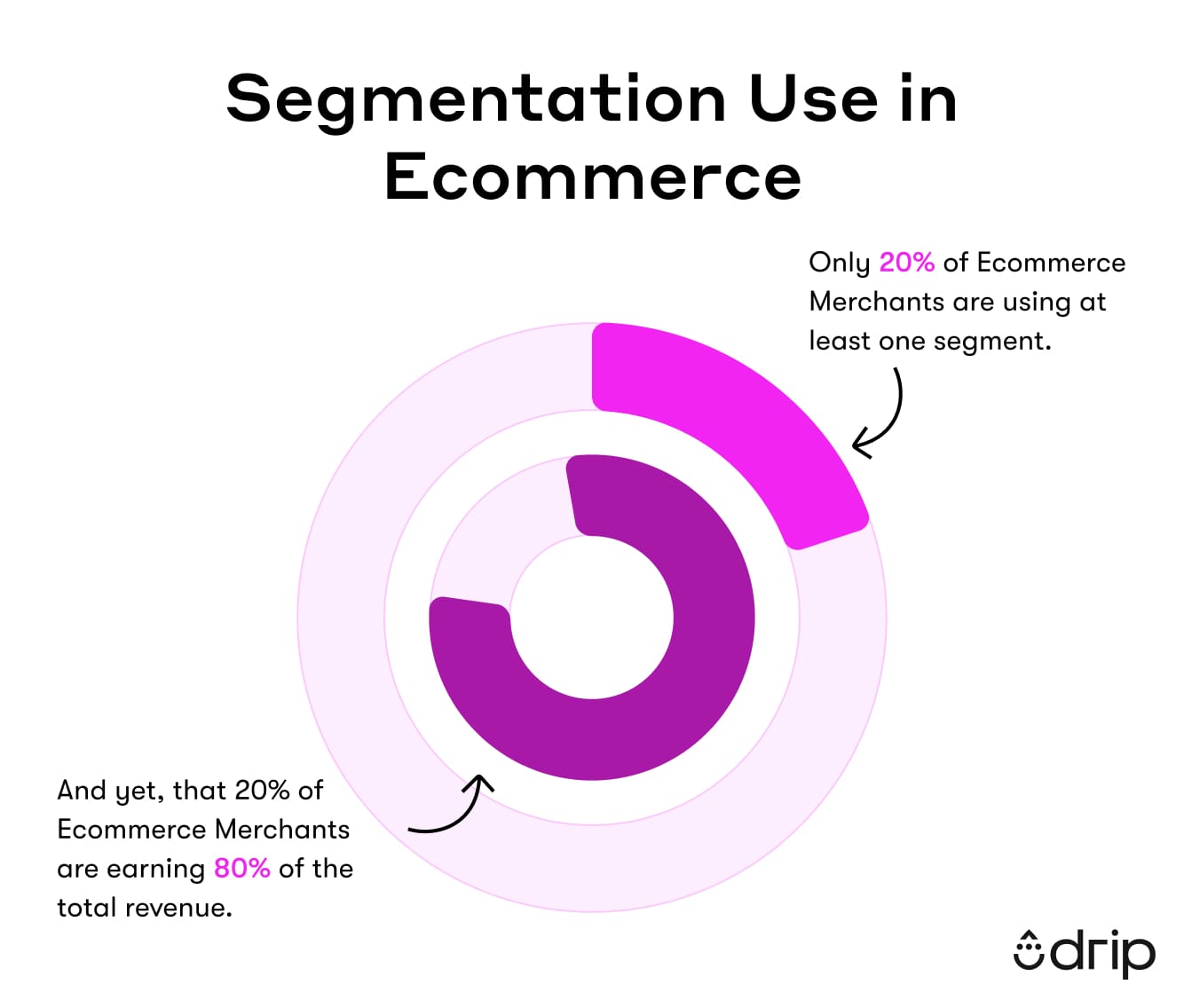
In fact, it goes even further: merchants who used more segments often earned more revenue as well.
On average, merchants using two or more segments earned 17 times the revenue of their counterparts using only one segment.
What could you do with 17 times more revenue?
Workflow Performance: The Classics and The Dark Horses
We dove head first into workflow data to better understand how ecommerce merchants were using the automation workflows, and most importantly, how they performed.
One thing to note: custom workflows made a disproportionate amount of the workflows we analyzed. Custom workflows scored highest in nearly every category.
This could be due to the sheer amount of them, but more likely than not, it has more to do with creating the workflows that make the most sense for your brand and your customers.
When we splice out custom workflows, cart abandonment made up over half of all workflows used over the year.
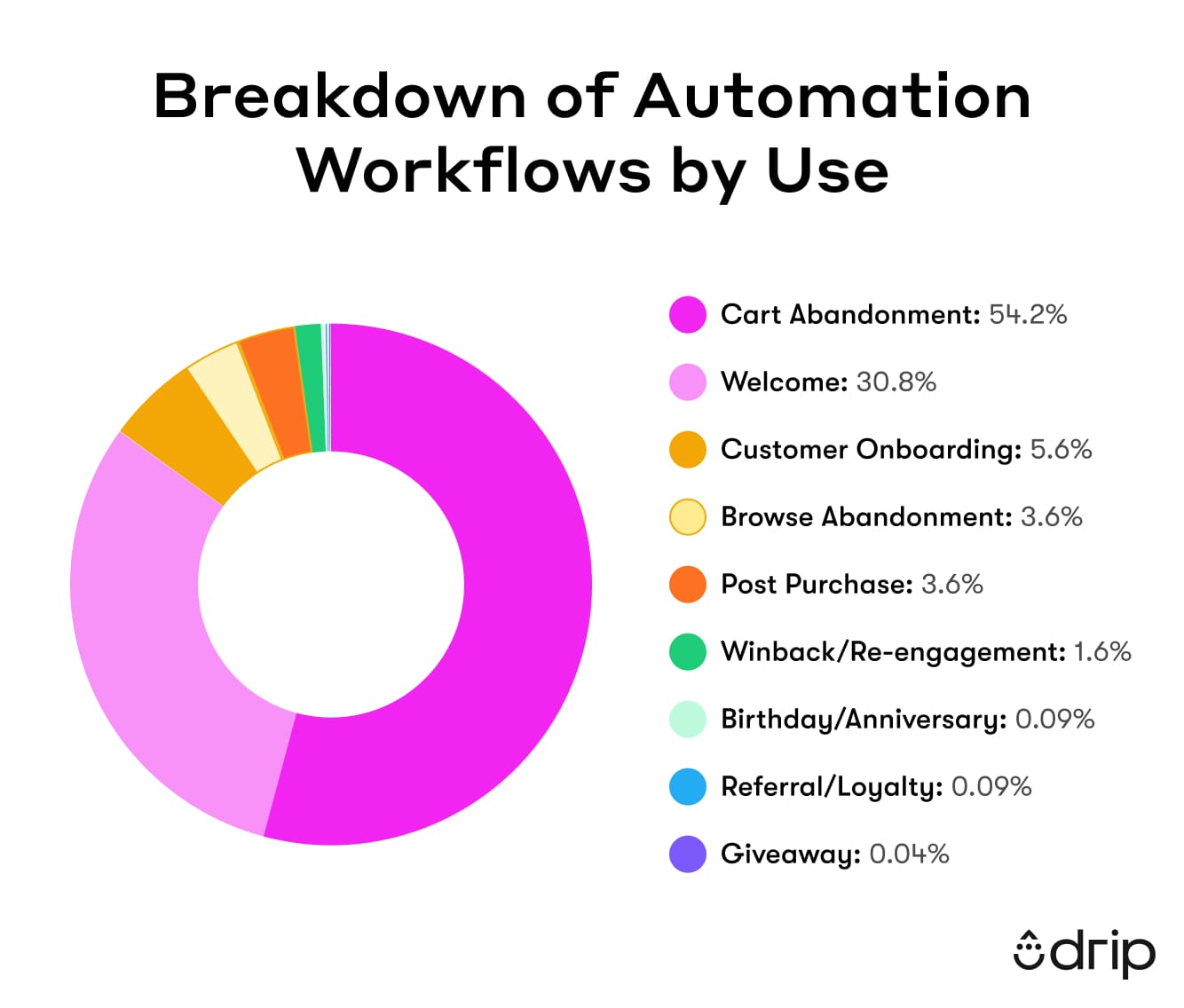 Welcome workflows comprised another 30.8%. The rest of the workflows in our list comprised the final 15%.
Welcome workflows comprised another 30.8%. The rest of the workflows in our list comprised the final 15%.
This data combined with overall performance from some of the more under represented workflows is something to keep in mind. There are some clear opportunities here for many ecommerce merchants.
How Workflows Performed Based on Open Rate
Anyone will tell you that open rate is the first thing to track when measuring performance - and even with all the recent changes to Apple’s privacy policies, open rates are still worth tracking for ecommerce merchants.
Among workflows sent out, the best click to open rates came from birthday or anniversary workflows at 24.43%. Every customer loves a little something sweet for their birthday, so it makes sense to lean into that incentive when you send out your birthday workflows.
If you don’t know your customer’s birthday, you can always use the sign up date as their anniversary. Any reason is a good reason to show your customer that you appreciate them.
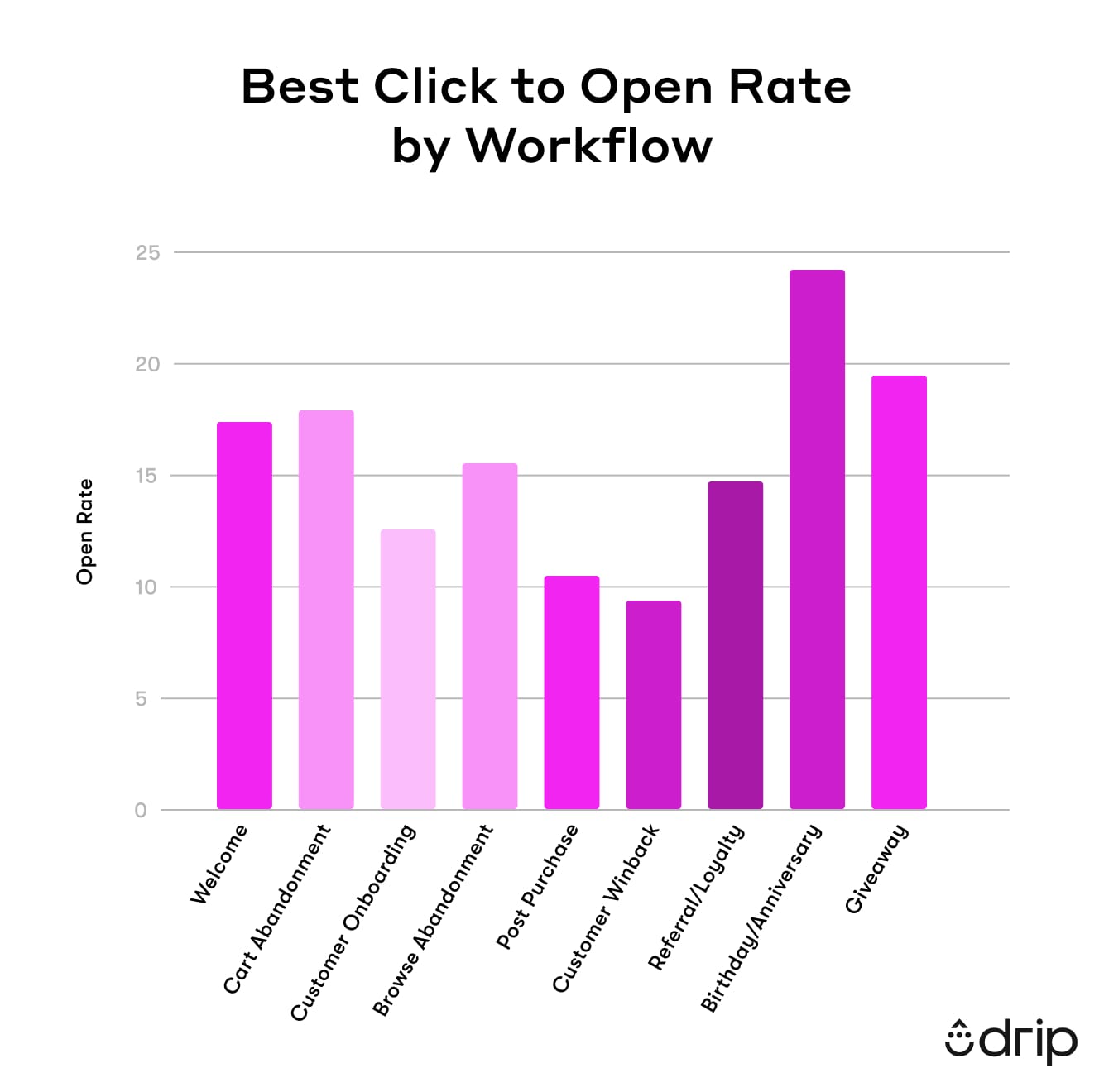 Following birthday/anniversary, giveaway automated workflows earned high open rates as well – 19.36%.
Following birthday/anniversary, giveaway automated workflows earned high open rates as well – 19.36%.
We can see a clear trend: offering something for free, whether it’s a birthday incentive or a giveaway, gets your emails opened.
From there, welcome (17.51%) and cart abandonment (17.17%) are neck and neck, with browse abandonment following at 15.94%.
With other workflows, ecommerce merchants struggled more to get eyes in front of their message.
All Click to Open Rates:
- Birthday/Anniversary: 24.43%
- Giveaway: 19.36%
- Welcome: 17.51%
- Cart Abandonment: 17.17%
- Browse Abandonment: 15.94%
- Referral/Loyalty: 14.84%
- Post purchase: 10.72%
- Customer Win back: 9.32%
How Workflows Performed Based on Click-Through Rate
When it comes to tracking real engagement, you can’t do much better than click-through rate. This tells you if your message was tempting enough to get the customer to want to know more.
For merchants last year, click-through rates were high across the board, with the crown going to referral and loyalty campaigns at 25.15%. Even if their open rates weren’t as high as others, those who did open were committed to learning more.
Welcome automations also performed well, coming in at 24.46%. This is where we see those sign-up incentives to purchase enticing customers back to the site.
Giveaway wasn’t far behind, reaching 23.1% – and combined with that already high open-rate, giveaway is looking like a star workflow for ecommerce merchants.
Post-purchase also makes sense at 21.36% – after all, who doesn’t compulsively open their order confirmation email and click to look at the products they’ve just ordered?
Only me? Fair enough.
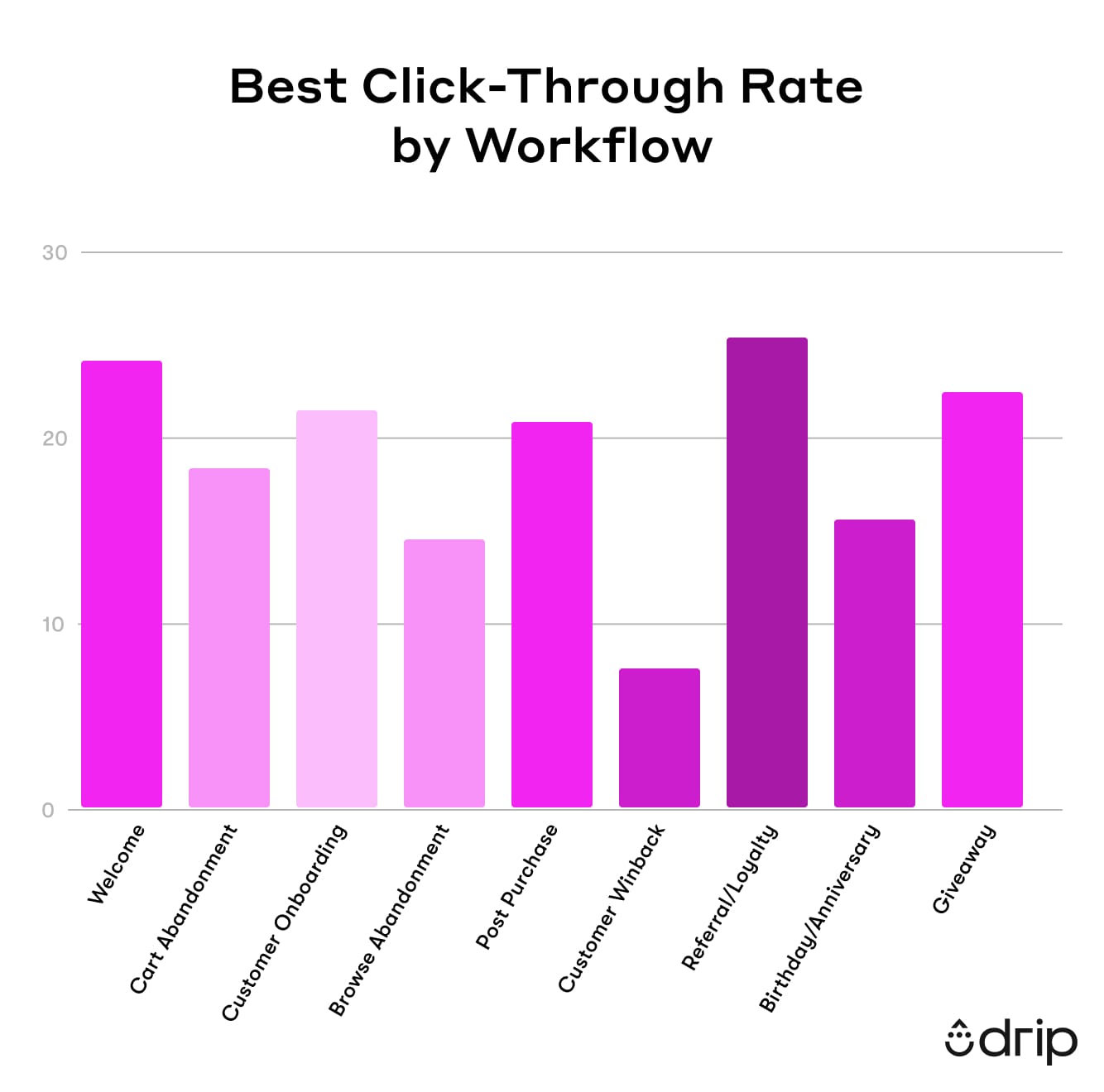 The only click-through rate that could be considered low was for customer win back email automations.
The only click-through rate that could be considered low was for customer win back email automations.
This makes sense when you account for the fact that these automation workflows are normally sent to inactive and churning customers. You can’t win them all back.
Total percentages for Click-Through Rates by Automation Workflow:
- Referral/Loyalty: 25.15%
- Welcome: 24.46%
- Giveaway: 23.05%
- Post Purchase: 21.36%
- Cart Abandonment: 17.98%
- Birthday/Anniversary: 15.86%
- Browse Abandonment: 15.09%
- Customer Win back: 7.21%
How Workflows Performed Based on Revenue
It’s clear that if there’s any automation workflow that earned ecommerce sellers the most revenue, it was the welcome series.
This makes perfect sense – a welcome series is often the first (and sometimes only) automation workflow they create. Arguably, a welcome series is the most important workflow you can create, as it’s the first real step a customer has in their customer journey with your brand.
The second most common workflow is cart abandonment, which is probably also the next most important workflow for ecommerce. And when it comes to total revenue generation, it’s easy to see why.
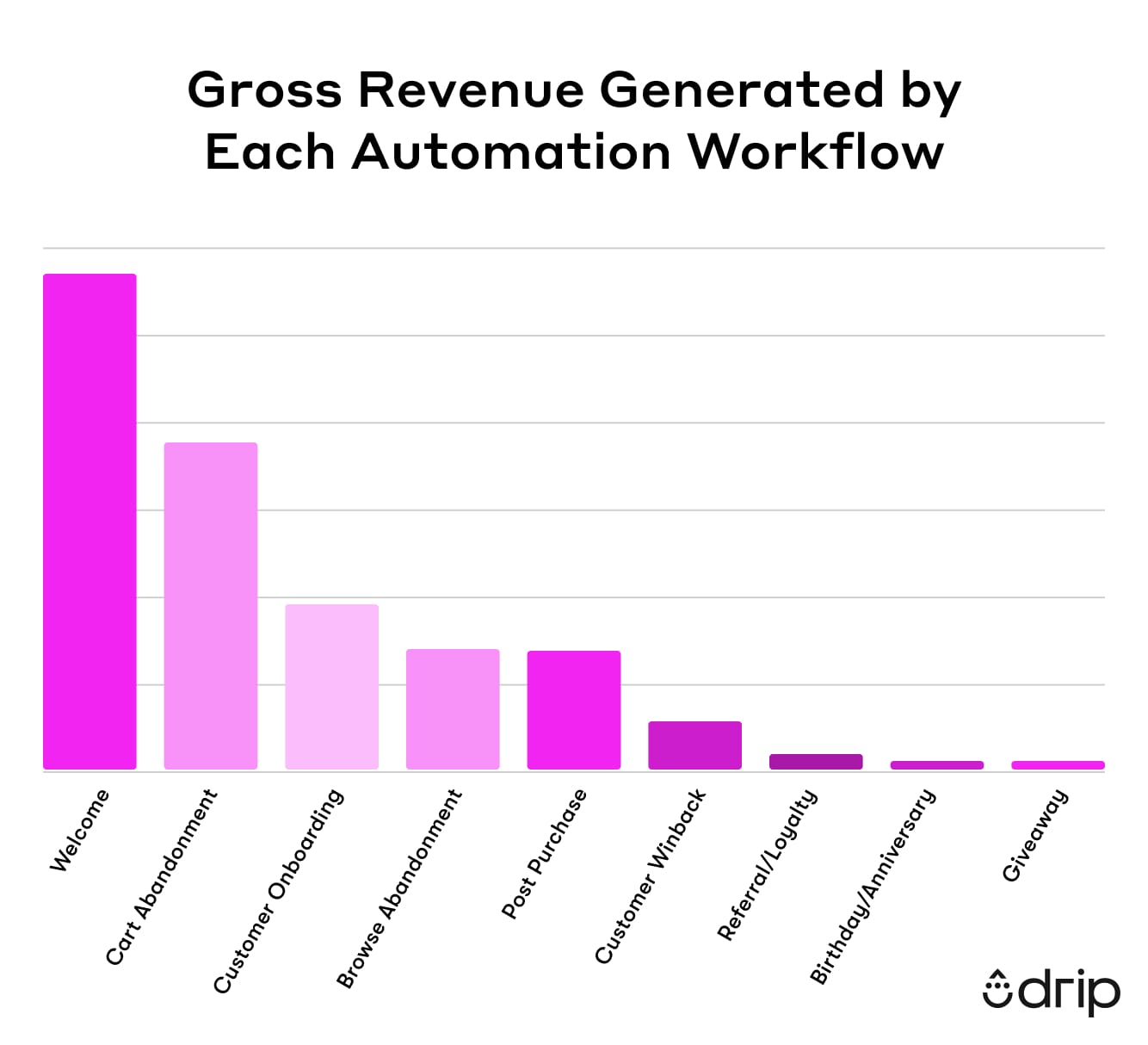 Cart abandonment workflows are the single best way to combat abandoned carts aside from optimizing your checkout. We can see from the total revenue split that these workflows are effective at recapturing that revenue.
Cart abandonment workflows are the single best way to combat abandoned carts aside from optimizing your checkout. We can see from the total revenue split that these workflows are effective at recapturing that revenue.
In fact, welcome automation workflows alone almost earned more revenue than all of the other workflows combined.
Between welcome and cart abandonment, it would be hard to see why anyone would use any other workflow. If these two are so effective, why not set them up and call it a day?
While cart abandonment and welcome workflows are highly effective, the scale of that revenue generation is largely attributed to their popularity.
Ecommerce merchants put them in place knowing that these two simple workflows can bring customers into their sales funnel, and plug any leaks that funnel might have.
However when we look at the average purchase per workflow, we see a very different story.
Referral and loyalty campaigns earn the most revenue per workflow sent, followed by giveaway, post purchase, and browse abandonment.
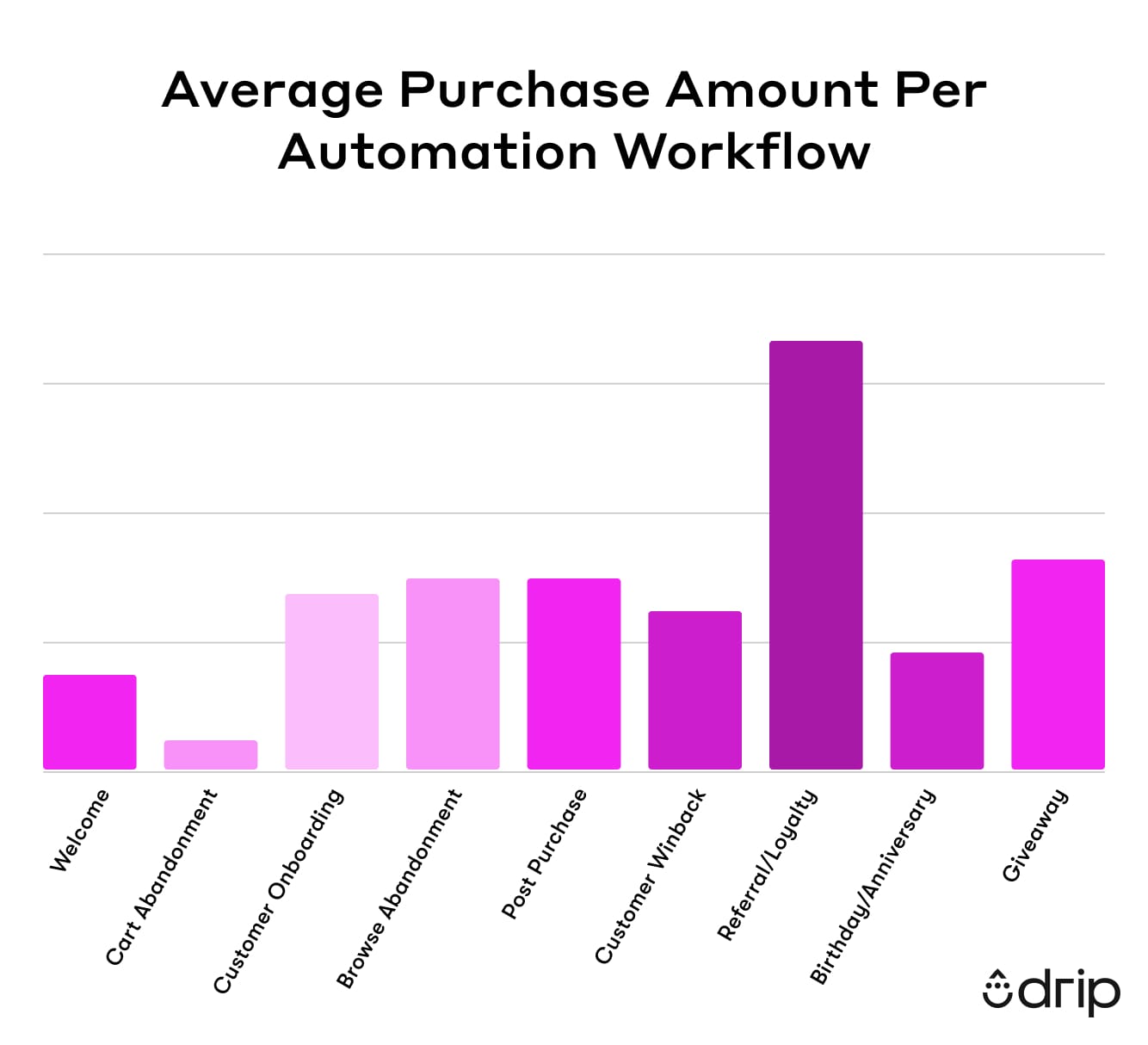 In fact, in average purchase per workflow, welcome and cart abandonment fall into the least amount of revenue earned.
In fact, in average purchase per workflow, welcome and cart abandonment fall into the least amount of revenue earned.
Does this mean you should forget them both and opt for the higher revenue-per-workflows instead?
Absolutely not.
It means you should explore the gamut of potential workflows for your ecommerce store. Welcome and cart abandonment are universally popular because they’re effective.
But neglecting your other workflows is leaving money on the table.

Drip Takeaways:
- 20% of merchants earn 80% of the total revenue: And it’s all thanks to segmentation. Adding real segmentation to your workflows can only bring more revenue.
- Just one segment isn’t enough: Merchants using two or more segments earn, on average, 17 times more revenue than merchants with just one segment. One segment will get you far, but more than one will take you so much further.
- This is your sign to run a giveaway: Giveaway and contest workflows were high-performers across the board. Combine entry with making a purchase that’s easy to commit to, and you’ve got a revenue generation machine.
- Lead with value: Put the value you provide clearly in your subject line – it might be the thing that gets your customers to open up!
- Don’t skip birthday and anniversary workflows: They’re an excellent way to show your customer you appreciate them – and they get some of the highest open rates of any automation workflow.
- Just because the open rate isn’t there, doesn’t mean the workflow isn’t valuable: Any marketer will tell you that the more you do something, the more varied results you’ll get. Although welcome and cart abandonment had lower open rates, they earned more overall revenue for merchants.
- Don’t forget loyalty campaigns: Referral and Loyalty had the highest click-through rates of any other automation workflow, despite being on the lower end of open rates. Be sure to lead with your value if you’re showing customer appreciation.
- Those who open also engage: With how variable open rates were across the board, seeing higher click-through rates for all workflows is a good sign of continued engagement. Focus on increasing those open rates to get that engagement to carry your customer towards a purchase.
- Referral and loyalty are your hidden revenue gems: If you’ve neglected these workflows to this point, this is your sign to get them in place. While they’re overall under-adopted, and even under-opened, they perform well with high-engagement customers and have high revenue earning potential.
- Don’t neglect the classics: Welcome and cart abandonment are still your most profitable workflows. Don’t let the lower revenue-per-workflow fool you – these will be your biggest revenue drivers.
When we consider the data, it’s clear that automation workflows will take ecommerce merchants further than sending one-off campaigns.
This isn’t to say that those single campaigns shouldn’t have a place in your strategy – au contraire. They’re great for flash sales, seemingly ad hoc promotions, and general news and updates.
But when it comes to nurturing your customer’s journey and their lifecycle with your brand, automation will be what makes the difference.
Getting those lifecycle-critical workflows in place will be what makes or breaks your revenue generation in 2024. Not only will you find that your job just got a lot easier, but you’ll also see a much higher ROI.
Not all marketing or email automation software are created for you. Some make it unnecessarily difficult to get those critical workflows in place – and few of them integrate natively with your ecommerce platform.
Luckily, Drip is made for ecommerce, and it makes automation workflow building a snap with free templates you can install in a click.
The best part? You can try Drip for free for 14 days – perfect to get those lifecycle workflows built and tested.
Glossary:
Automation Workflow Definitions:
Automation workflows are a critical part of marketing automation. These are the sequences you create with two or more emails (or messages from other channels) that are sent on a timed or triggered automated basis. The trigger can be a variety of events (signing up, abandoning a cart, abandoning a product search, looking into return policies, etc).
Birthday workflows are meant to delight your customers with a special offer or their birthday. This same mechanic can be used for the anniversary of sign up, often called an anniversary workflow.
This automated workflow is similar to cart abandonment, except your customer doesn’t need to have something in their cart to trigger it. Browse abandonment is typically triggered when a customer browses a particular category and leaves the site without having completed a purchase. They normally receive messages with products from the category they were browsing.
Not to be confused with a Welcome series, customer onboarding is an automation workflow that’s sent once your customer has made their first purchase. This is also a great moment to give your customer extra information or help them get the most out of their new purchases.
A popular workflow, this automated sequence helps you recover customers who have left your site with items in their cart. This can happen before they’ve started the checkout, or at any point during the process. The customer is normally sent an email reminding them of the products they’ve left behind.
Giveaway sequences are usually timed out workflows to promote a certain giveaway or contest.
A post purchase flow is a wider category. They can include several varieties of emails, such as order confirmation, shipping updates, upsell or cross sell recommendations, and more. There are a ton of opportunities to reach out to your customers once they’ve made a purchase – and this is a valuable workflow to have.
Referral and loyalty workflows are often used to increase customer retention and boost acquisition through the customers you already have. These messages can range from review and referral requests, loyalty program updates, VIP messaging and more.
Also known as welcome flow, or welcome series, this is the automated workflow you put in place to welcome in a new subscriber. This is typically for a contact that has subscribed for some kind of incentive.
A winback (also known as re-activation or re-engagement) workflow helps you recover customers that have or are about to churn.
Tracked Metrics:
Click through rate refers to the percentage of subscribers who clicked a link in the email after having opened it.
Open rate is the percentage of subscribers who opened the email by clicking on it compared to the number who received it. When we calculate this for a workflow, we count each individual email within that workflow.
We use this metric to calculate the total amount of revenue generated by that workflow across all merchants.
Purchase per workflow accounts for the total amount of revenue generated by a certain workflow type, divided by the number of those workflows sent.


